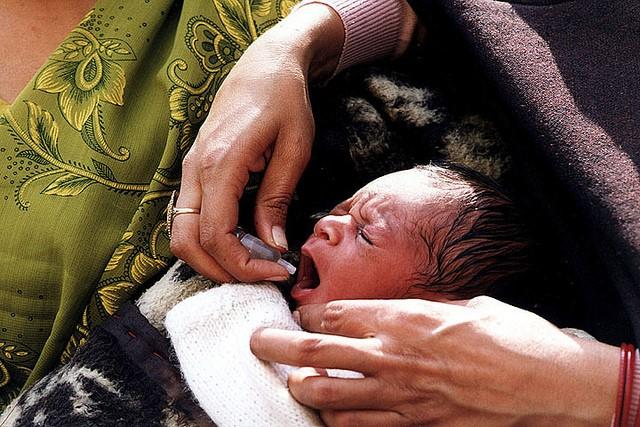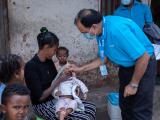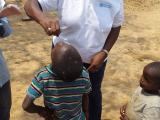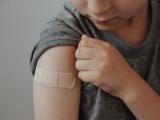In 2017, the number of global wild poliovirus (WPV) cases sank to its lowest level, and though surveillance markers are improving in many countries, remaining gaps mean that progress is fragile, according to a new snapshot that looked at trends for 2016 and 2017.
Experts from the World Health Organization (WHO) and the US Centers for Disease Control and Prevention (CDC) reported their findings today in the latest edition of Morbidity and Mortality Weekly Report (MMWR).
In 2017, only 22 WPV cases were reported in just two countries—Afghanistan and Pakistan. That total was down from 37 cases in 2016 in those two countries along with Nigeria. Against that backdrop, the number of circulating vaccine-derived poliovirus 2 (cVDPV2) rose over the past 2 years, fueled by outbreaks in the Democratic Republic of Congo and Syria.
According to the Global Polio Eradication Initiative (GPEI), for 2018 so far, only seven cases have been reported, six in Afghanistan and one in Pakistan. In its latest weekly update posted today, GPEI said no new cases of WPV or cVDPV2 were reported for the week ending Apr 11.
In February, the WHO's polio emergency committee met for the 16th time, agreeing to extend the public health emergency of international concern and its related temporary health recommendations.
Access, conflict play roles in gaps
Since intensive efforts began in 1988 to eradicate polio, four of the six WHO regions have been certified as polio-free. Much of the recent focus has been on countries in the Eastern Mediterranean and African regions, especially three that have yet to interrupt WPV transmission: Afghanistan, Pakistan, and Nigeria.
The authors note that two metrics are used to measure the quality of acute flaccid paralysis (AFP) surveillance, a nonpolio AFP rate of 2 or more and adequate stool specimens from 80% or more of patients who have AFP. For 2017, 14 of 20 African countries evaluated met national surveillance indicators, up from 12 in 2016. Last year, however, 5 of 6 countries in the Eastern Mediterranean region met the quality indicators, down from all 6 in 2016.
"Although overall performance improved in 2017, national-level surveillance indicators masked suboptimal surveillance performance at subnational levels in both regions," the group wrote, acknowledging that inaccessible and conflict areas are vulnerable to gaps in tracking.
Regarding sewage sampling, done to flag polio transmission when AFP cases aren't detected, Afghanistan had WPV1 from four genetic clusters in five provinces in 2017, and in Pakistan, 13% of samples were positive for WPV1 in 2017, with positive samples from all five provinces. In Africa, recent positive samples included cVDPV2—from Nigeria's Borno state in 2016 and from Somalia in 2017.
Genetic clues
The investigators report that genetic diversity declined in 2017 WPV1 isolates. But 3 of 22 specimens from Afghanistan and Pakistan were considered orphan isolates, with a lower level of genetic relatedness, hinting at possible gaps in AFP surveillance.
Regarding recent cVDPV2 strains, the scientists observed viruses that have diverged from the Sabin parent strain, both in stool specimens from patients with AFP and in environmental samples from the three countries.
Surveillance challenges in conflict areas
Though conflict situations limit standard health-facility surveillance, community-based surveillance has been effective at finding AFP cases, the team wrote. For example, strategies include increasing case searchers at internally displaced persons camps, involving the participation of community members in inaccessible areas, and employing active case-searching in newly accessed areas.
"For example, in Somalia, community volunteers have been instrumental in reporting AFP cases in inaccessible and partially accessible areas," they wrote.
They emphasized that the need for strong polio surveillance will remain beyond eradication certification and well after the oral poliovirus vaccine has been phased out globally. "As long as polioviruses continue to circulate in any country, all countries remain at risk," the authors wrote.
Still a bumpy road toward eradication
A report from Stat today said 2018 marks the 30th anniversary of the global polio eradication push, and despite recent optimism, experts don't think this year will see the end of the disease.
Michael Zaffran, director of polio eradication for the WHO, told Stat that experts hope polio spread in southern Afghanistan this year can be stopped, but they are worried about cases in the northeast of the country, an area in which deploying the vaccine and monitoring its use pose safety risks.
On the other hand, Zaffran said developments in Nigeria are raising hopes that polio transmission will be interrupted there, if it hasn't been already. He noted that vaccinators have been able to reach more children, and that no cases were reported in people or in sewage samples in 2017.
He also said the global supply of injectable polio vaccine is starting to increase, with more producers and with them more supply expected in 2020.
See also:
Apr 12 MMWR report
Apr 12 GPEI weekly polio update
Apr 12 Stat report




















